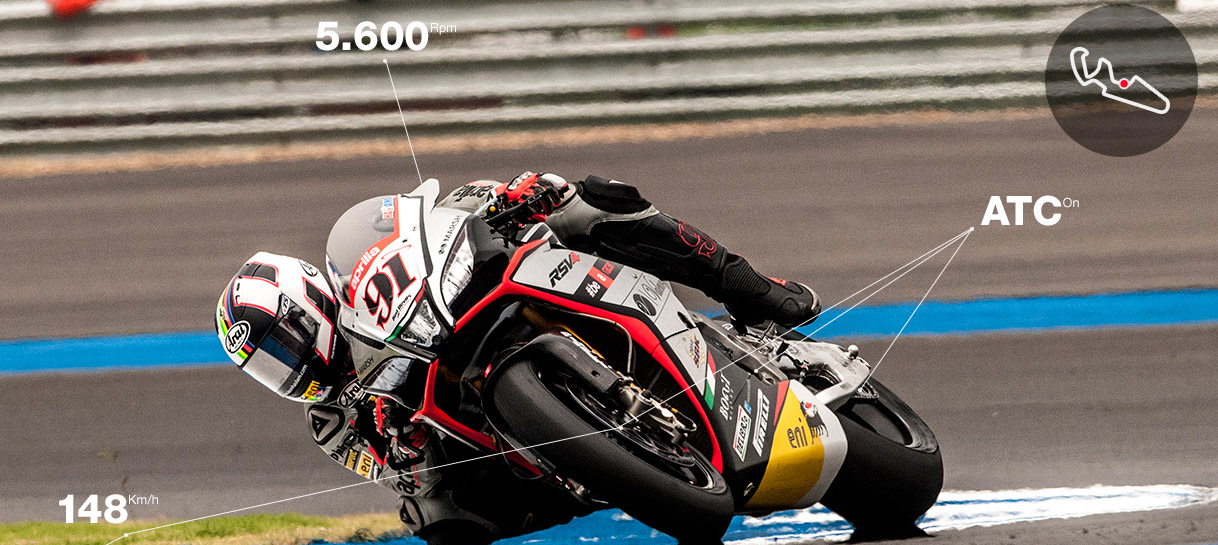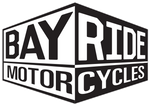
Braking with cornering ABS: the right technique!
Associating the pure emotion of riding with the cold silicon of circuit boards may or may not please us racers, but we have to admit that for some years now the technological innovations that are most disrupting the world of two wheels are always in the sphere of on-board electronics.
It’s no coincidence that Aprilia has always been a pioneer in the development of electronic systems, first applying them to the racing bikes and then transferring them to the range. The APRC (Aprilia Performance Ride Control), the dynamic control suite that equips RSV4 and Tuono V4, has now almost reached the state of the art. It is the most complete and sophisticated of those currently on the market and includes an extensive series of functions including ATC (Aprilia Traction Control), AWC (Aprilia Wheelie Control), ALC (Aprilia Launch Control), AQS (Aprilia Quick Shift); enough acronyms to use all the letters of the alphabet, but what we’re interested in today is the one that is apparently the simplest and “oldest” of all: ABS!

The anti-lock braking system, better known as ABS, was by far the first to significantly increase driving safety. Since its very first versions, with a somewhat intrusive operation to tell the truth, it allowed us to reduce stopping distances in many driving conditions, provided however that we changed the way of driving and braking (or at least that’s what we should have done).
Today the direct descendent of this system is what is called “cornering ABS”, and like its predecessor it promises a leap forward in terms of safety. But in order to be exploited to the fullest, it requires us to adapt our driving technique to a new way of taking curves on the road. An important fact that many people simply overlook.
All versions of Aprilia RSV4 and Aprilia Tuono V4 1100 are equipped with Bosch 9.1 MP ABS with cornering function, adjustable on 3 maps and equipped with RLM (Rear wheel Lift-up Mitigation) strategy that limits the lift of the rear wheel during more abrupt braking. A system that offers exceptional performance but requires a certain level of awareness and learning in order to be used to its full potential!
First, a little history
Let’s start from the beginning. At the turn of the ’80s and ’90s, the first phonic wheels for ABS systems began to appear on road bikes. Like all the electronics applied to motorbikes, these systems were directly derived from the automotive world, which usually precedes the two-wheeled one by about ten years, and they were also a bit crude. They struggled to win the approval of enthusiasts, because they were actually somewhat impractical, if not at times counterproductive. But the good thing (and the bad) about electronics is its very rapid ability to be updated, making everything more efficient and making the rest obsolete.
This was the case for the next 20 years, during which two-channel ABS systems evolved though without changing radically, becoming more and more refined in their intervention and thus making friends with motorcyclists. Release after release, software and actuators decreased the read time while in parallel increasing the frequency of response. The German company Bosch invested extensively in this sector, but also Aprilia didn’t just stand by and watch. Everything was more acceptable and safe, the braking that got longer due to the pulsations on the brake levers was less and less, and ABS systems started to become the faithful travel companions of many enthusiasts.

But the real turning point came around 2010, with the adoption of the first inertial platforms: small circuit boards equipped with motion sensors and accelerometers that were basically able to detect with great precision what the bike was doing. The ABS no longer only calculated the difference in wheel rotation, but it knew how the bike was moving in space, what and how many forces were at play, as well as reading the pressure exerted on the front and rear brakes, the gear engaged, and whether the throttle was open. Remember the old prehistoric combined hydraulic or mechanical braking systems? Well, now the system is able to modulate braking between front and rear in a perfect way to keep the bike on course, as well as not blocking the wheels. Cornering ABS is born!

Braking on curves? Now you can!
Cornering ABS is so efficient that it can change the rules of handling the bike when cornering. The self-straightening force caused by the front brake practically disappears, making everything much easier and safer. Before, the golden rule was not to use the front brake, or at least use it with great care, relying on the rear brake instead, the only interpreter of the trajectory and able to close one that was too wide or help to maintain it on downhill curves. Now all this continues, thank goodness, but it is no longer mandatory to apply it.
When the system is active, if you want to slow down when cornering, it is possible to brake even with the front brake alone to decelerate without the bike going wide in the slightest, also sure to be protected from any loss of rear grip. The electronics autonomously regulates the braking between front and rear in real time, and the bike moves forward as if on a rail. It might seem like a mockery to those who spent so much time learning the “old” brake management in cornering, but for everyone the advantages are really huge. For safety’s sake, however, we advise you not to abuse this confidence: acting recklessly on the brakes, even if the system is designed to handle any situation, is not true racer behaviour :)
Braking and keeping your bike upright… in all conditions!
It may not sound like something new, but the latest cornering ABS evolutions can perfectly handle all conditions of braking with the bike upright, determining whether you are braking downhill, uphill, or with a passenger on board, modulating the front and rear braking force accordingly.
In the event of emergency braking, it’s possible to act on both brakes firmly, in this case with full confidence in the electronics. In instrumental braking tests, a good tester still manages to have shorter braking distances without ABS, but in this case we’re talking about asphalt with excellent grip, totally uniform, and above all the best of various braking attempts. These conditions are practically unrepeatable compared to the thousands of possible variations on the road, so the advice is to always leave the cornering ABS of our Aprilia V4 activated, even on the track, where the system was developed to transmit an exceptional sensation even in the most experienced hands. Of course, if we want to do a couple of laps without it, we can always turn it off and go full throttle: our bike is always an Aprilia even without it!
Have you explored the levels of advanced technology on your bike or do you just ride and ignore. Let us know your thoughts!




